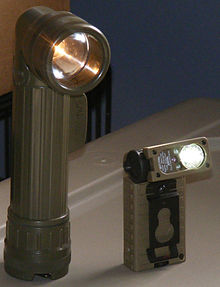Accessories
Translucent, colored plastic cones slipped over the lens of a flashlight increase the visibility when looking at the side of the light. Such marshalling wands are frequently used for directing automobiles or aircraft at night.
Colored lenses placed over the end of the flashlight are used for signalling, for example, in railway yards. Colored light is occasionally useful for hunters tracking wounded game after dusk, or for forensic examination of an area.
Other designs
A penlight is a small, pen-sized flashlight, usually containing two AA batteries or AAA batteries. In some an incandescent light bulb has an integral lensthat focuses the light, thus no reflector is built into the penlight. Others use incandescent bulbs mounted in reflectors, while LED lamps are becoming increasingly common. Low-cost units may be disposable with no provision for the user to replace batteries or bulbs, and are sometimes imprinted with advertising for promotional purposes.
A headlamp is a flashlight designed to be worn on the head. A headlamp usually consists of the light emitter at the front, with a battery pack also attached to the front or back. The battery pack may be attached to the back of the head or in a pocket to improve balance. Headlamps leave the user's hands free, making them popular for recreational and occupational activities.
Sometimes a tactical light is mounted to a handgun or rifle.Such lamps are designed to withstand the impact of recoil, and to be easily controlled while holding the weapon.
Most flashlights are cylindrical in design, with the lamp assembly attached to one end. However, early designs came in a variety of shapes. Many resembled modern day lanterns, consisting largely of a box with a handle and the lamp attached to the front. Some others were made to have a similar appearance to candles. Hand-held lanterns using larger batteries give greater running time, and, with large reflectors, can produce more concentrated beams better adapted to long-distance use.
Although most flashlights are designed for user replacement of the batteries and the bulb as needed, fully sealed disposable flashlights, such as inexpensive keyring lights, are made. When the batteries are depleted or the bulb fails, the entire product usually is thrown away or recycled and a new one purchased to replace it.
Diving lamps must be watertight under pressure and are used for night diving and supplemental illumination where surface light cannot reach.
People working in areas with significant concentrations of flammable gases or dusts, such as mines, engine rooms of ships, chemical plants or grain elevators, use so-called "non-incendive", or "explosion proof" flashlights. These are constructed so that any gas or dust that leaks into the flashlight is not likely to set off an explosion outside the light. The flashlight may require approval by an authority for the particular service and particular gases expected. The external temperature rise of the flashlight must not exceed the autoignition point of the gas, so substitution of more powerful lamps or batteries may void the approval.
Portable hand-held electric lanterns can provide larger reflectors, lamps, and batteries than tubular flashlightsmeant to fit in a pocket. They are often designed for lighting the broad area immediately around the lantern, as opposed to forming a narrow beam; they can be set down on a level surface or attached to supports. Some electric lanterns use miniature fluorescent lamps for higher efficacy than incandesent bulbs.
Power sources
The most common power source for flashlights is the battery. Many types of batteries are suitable for use inflashlights, such as button cells, carbon-zinc batteries in both regular and heavy duty types, alkaline , lithium andrechargeable lead acid batteries, NiMH, NiCd batteries and lithium ion batteries. The choice of batteries will depend on the light source used, and will usually play a determining role in the size and shape of the flashlight. Flashlightsadapted for use with secondary batteries may include features to allow charging without removing the batteries from the light, for example, a light kept in a vehicle may be trickle-charged and always ready when needed. At least one manufacturer makes a rechargeable flashlight that uses a supercapacitor to store energy.
Some flashlights are solar powered, using the energy generated from a solar cell to charge an on-board battery for later use.







